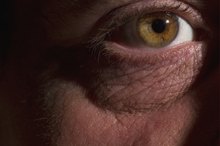What does fact checked mean?
At Healthfully, we strive to deliver objective content that is accurate and up-to-date. Our team periodically reviews articles in order to ensure content quality. The sources cited below consist of evidence from peer-reviewed journals, prominent medical organizations, academic associations, and government data.
The information contained on this site is for informational purposes only, and should not be used as a substitute for the advice of a professional health care provider. Please check with the appropriate physician regarding health questions and concerns. Although we strive to deliver accurate and up-to-date information, no guarantee to that effect is made.
Exercise After a Blepharoplasty
A blepharoplasty, or eyelid lift, is a surgical procedure in which excess skin is removed from your upper eyelids 2. The procedure is most often a cosmetic concern, though in some severe cases the sagging of excess skin can interfere with your vision and creates a medical cause for removal. Exercise after a blepharoplasty can be phased back into your life in stages, with the permission of your doctor.
Post-Operative Expectations
After your eyelid surgery, your eyes will be very swollen and bruised, and you'll experience pain and blurry vision. Keeping your head in an upright position and applying ice packs to your face can dull the pain and control the inflammation. Your surgical wounds will be stitched up and you'll be given pain medications as well as antibiotic ointment to prevent infection.
Early Recovery
Swimming After Vasectomy
Learn More
An eyelid lift is an outpatient procedure for most people, which means you'll go home the same day as your surgery 2. Heavy exercise is not recommended for several weeks after the procedure, as the risk of elevating your blood pressure can hamper the healing process. Johns Hopkins Medicine notes that walking is recommended in the early recovery phase, but take it easy. This should not be the brisk, workout type of walking to which you may be accustomed, but light exercise to promote circulation and healing. Avoid exercises that require you to bend over, lift heavy weights or vigorous contact sports or running for up to three weeks.
- An eyelid lift is an outpatient procedure for most people, which means you'll go home the same day as your surgery 2.
- Heavy exercise is not recommended for several weeks after the procedure, as the risk of elevating your blood pressure can hamper the healing process.
Getting Back to Exercising
Your swelling, bruising and pain will have subsided significantly by the third week post-surgery, according to Johns Hopkins Medicine 1. At this point, if your doctor gives you a green light, you can return to your regular exercise regimen. Start off slowly and listen to your body; if your eyes or face hurts, swells or bleeds, stop your workout and contact your doctor for further instructions. Healing from a blepharoplasty continues for many months after the procedure, so keep this in mind as you exercise.
- Your swelling, bruising and pain will have subsided significantly by the third week post-surgery, according to Johns Hopkins Medicine 1.
Considerations
Problems After Retinal Holes Laser Surgery
Learn More
Because a blepharoplasty is surgery on your eyelids, the skin around your eyes will be affected, as will your vision for the first few days. Refrain from engaging in exercise that requires you to wear protective goggles, such as swimming, skiing or other contact sports, until your doctor clears you for these activities. Protective eyewear may not fit securely around your face until the swelling has subsided. Your impaired vision also plays a role in your ability to exercise after blepharoplasty. Participating in exercise that requires you to track balls or other objects may not be safe until your vision has returned to normal.
- Because a blepharoplasty is surgery on your eyelids, the skin around your eyes will be affected, as will your vision for the first few days.
- Refrain from engaging in exercise that requires you to wear protective goggles, such as swimming, skiing or other contact sports, until your doctor clears you for these activities.
Related Articles
References
- Johns Hopkins Medicine: Eyelid Surgery (Blepharoplasty)
- MedlinePlus: Eyelid Lift
- American Society of Plastic Surgeons. Eyelid Surgery.
- Bhattacharjee K, Misra DK, Deori N. Updates on upper eyelid blepharoplasty. Indian J Ophthalmol. 2017;65(7):551-558. doi:10.4103/ijo.IJO_540_17
- American Society of Plastic Surgeons. Eyelid Surgery Recovery and Results.
- Drolet B, Sullivan P. Evidence-based medicine: Blepharoplasty. Plastic and Reconstructive Surgery. 2014. 133(5):1195-205. doi:10.1097/PRS.0000000000000087
- Karimnejad K, Walen S. Complications in Eyelid Surgery. Facial Plast Surg Clin North Am. 2016;24(2):193-203. doi:10.1016/j.fsc.2015.12.008
Writer Bio
Erica Roth has been a writer since 2007. She is a member of the Society of Professional Journalists and was a college reference librarian for eight years. Roth earned a Bachelor of Arts in French literature from Brandeis University and Master of Library Science from Simmons College Graduate School of Library and Information Science. Her articles appear on various websites.









